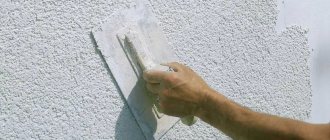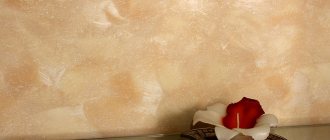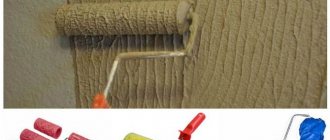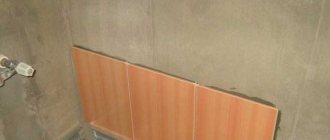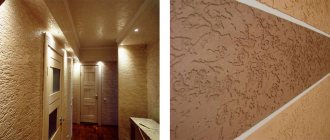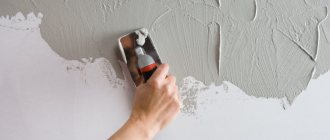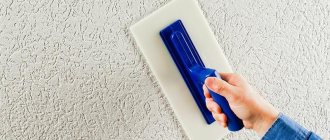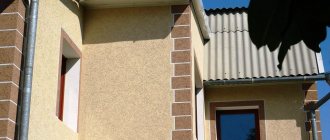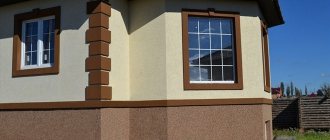Bark beetle putty is a material intended for decorative finishing indoors and outdoors. It allows you to get an unusual texture. Externally, the surface after hardening is similar to the structure of wood damaged by insects. There are ready-made mixtures that already contain pigment, but the color can be purchased separately and you can get the composition of the desired shade. The technique of applying this material is extremely simple, so even beginners can master it.
Purpose and application
Bark beetle putty has a wide range of applications.
It has high adhesion, so the mixture can be applied to different types of surfaces, including:
- concrete;
- tree;
- plywood;
- chipboard;
- drywall;
- brick, etc.
However, this material cannot be used to decorate glass and metal elements. Not only walls, but also ceilings are treated with “bark beetle” putty. This finishing composition is used for both facade and interior work.
The resulting coating is resistant to ultraviolet radiation, moisture, temperature changes and other atmospheric phenomena. For interior decoration, this type of putty is more often used if you plan to decorate the room in a classic or antique style. The material is often used in the restoration of old buildings.
Preparing the mixture
The following types of plaster are used to decorate walls using bark beetle technology:
- High-quality silicone containing natural resins;
- The most expensive are silicate ones, based on liquid glass;
- The cheapest and most practical cement-based mineral;
- Acrylic - very convenient to use, but poorly resistant to sunlight.
Bark beetle putty, purchased in the form of a dry powder with the addition of solid particles, is diluted with water before application. To do this, take a large container so that the hand with the tool can fit into it when working. Water temperature 20°–23°. It is better to mix with a construction mixer or a drill turned on at medium speed.
Acrylic bark beetle plaster is sold ready-made, painted in various colors. If it is white, you can add the desired color and stir. Important! All other bark beetle mixtures cannot be tinted . They are poorly and unevenly painted; a large amount of dye can reduce the quality of the material.
Composition and technical characteristics, consumption per 1 m2
Putties are available both in the form of a dry mixture and a ready-made paste. The basis of the material is cement with polymer resins. The type of additive affects the technical characteristics of the finished coating.
Compositions with acrylic resin are used to prepare mixtures intended for finishing facades, because they are characterized by increased resistance to environmental factors. The service life of such coatings is 15-20 years. Products containing silicate-silicone mixtures have antistatic properties. They are more often used for interior decoration. Compositions containing a silicone additive are vapor permeable. They are often used for finishing wooden surfaces.
An important component of the putty is marble chips. The size of its fraction is 1.5-3.5 mm. The larger the granules, the deeper the grooves, but this leads to increased material consumption due to the need to apply a thick layer. Additionally, mineral fillers and other additives are added to the putties.
The consumption of the product depends on the form of its release, the density of the mixture, and the fraction of marble chips. In addition, when calculating the required amount of putty, the degree of surface preparation and application technique are taken into account. The size of the granules plays a special role. If the fraction is large and the solution is applied in a thin layer, the crumbs will crumble, and if it is too thick, they will drown in it, not leaving the desired relief.
Thus, if the granule size is 3 mm, then the layer thickness should be at least 3 mm. These values are used when calculating the quantity of material. To do this, multiply the surface area by 0.003 m.
To accurately determine the putty consumption in kg/m², you should take into account the density of the finished solution. This indicator varies among mixtures from different manufacturers.
Peculiarities
The construction market offers the buyer two forms of plaster - ready-made paste or dry polymer-cement plaster, which should be diluted with water. It is logical to assume that 1 kg of dry composition after dilution with water will give more weight than the same 1 kg of paste mixture purchased.
A huge advantage is that the dry product has an affordable price, which is covered by some inconveniences in its use.
All ready-made solutions are divided into several categories:
- acrylic;
- silicate;
- silicone.
Advantages and disadvantages
Putty under the “bark beetle” has many advantages:
- high coating strength;
- environmental friendliness;
- resistance to temperature changes (in the range -55...+60°C) and ultraviolet radiation;
- high fire resistance;
- light weight of the material;
- large palette;
- ease of surface care;
- ease of installation;
- low price, etc.
In addition, the mixture is characterized by increased biological resistance, i.e. Fungus does not form on the coating after hardening. The disadvantages of this material include the inability to eliminate defects that appear as a result of mechanical stress on the surface.
How to apply decorative bark beetle plaster by machine
For plastering large surfaces, special devices can be used. They independently prepare the composition from water and a dry mixture of the required consistency. Then the plaster is delivered through hoses to the surface of the wall. To distribute it, different nozzles are used.
After application, the coating is leveled manually using a spatula. Large area walls can be primed using a spray gun. Finishing surfaces by machine allows you to save plaster mixture. It is used mainly for facade work. It is not profitable to buy such a device to renovate your apartment.
Tips and recommendations for use
Before applying bark beetle putty, you need to study the recommendations regarding the technology for applying the composition. In addition, you should buy all the necessary tools and properly prepare the surface.
Materials and tools
First of all, you need to purchase putty in the form of a paste or dry mixture, as well as a primer.
The tools that will be required for the job include:
- bucket;
- construction mixer;
- narrow and wide spatulas;
- brushes;
- plastic grater;
- roller;
- spray bottle, etc.
Preparation of the grounds
The quality of the coating largely depends on the thorough preparation of the base. First of all, the surface must be cleaned of dust. You can use a stiff brush for this. In addition, foci of fungus should be eliminated and a primer should be applied. Features of further preparation depend on the location of the surface and its type.
Bark beetle putty is often used to decorate building facades. It is often applied on top of an insulating pie. In this case, mineral wool or polystyrene foam is first glued to the wall. All joints are sealed with polyurethane foam or glue. Then a reinforcing mesh is fixed to the surface. After this, you can begin applying facade plaster. If insulation is not planned, the surface should be leveled with cement mortar. After the plaster has dried, the facade can be puttied.
If you need to prepare internal walls made of blocks or bricks, you must first thoroughly clean them, and then install beacons and level the surface with plaster. Only after this can finishing be carried out. If a decorative layer needs to be applied to an already plastered base that does not peel off, but has large unevenness, you can hide them with putty.
If the walls are made of concrete slabs or plasterboard, you need to seal the seams with cement mortar. It is extremely important that cracks do not appear in this area in the future. Only after the solution has dried can you begin to putty the entire wall.
Priming technology
Applying a primer is an important step in surface preparation. The solution treatment technology depends on the type of base. If the walls were previously covered with oil paint, they must be thoroughly sanded. The primer can be applied either with a roller or with a brush. If the old decorative coating does not adhere well, it should be removed first. It is recommended to choose a primer from the same manufacturer as the putty. If the surface is highly porous, you need to use acrylic-based deep penetration compounds.
Preparation and application of the composition
If necessary, you can prepare your own putty from a dry mixture. You should carefully study the instructions for the composition. For dilution you will need water, the temperature of which should be about +15°C.
The required amount of liquid must be poured into a large bucket, and then the putty must be added. You cannot pour the dry mixture into water. Then use a construction mixer to thoroughly mix the material. In this case, the device should be set to a mode with a minimum number of revolutions. When all the lumps are dissolved, leave the mixture for 5 minutes and then beat it again with a mixer.
It is necessary to begin work immediately after preparing the putty. The room temperature should be +15…+25°C. Use a spatula to take a small amount of solution from the bucket. Then it should be distributed over the surface of the wall. The thickness of the applied layer should be minimal. You need to ensure that the surface is level.
It is recommended to immediately treat the entire wall with the solution. If this is not possible, cover the edge with masking tape. This will prevent the putty from drying out. In the future, it will be possible to continue work without the risk of the boundary line appearing. After about 30 minutes, the composition will begin to harden on the wall. The coating must be treated with a plastic float to give it a pronounced texture.
Main mistakes when applying bark beetle
Most of the mistakes made can be divided into groups:
- preparing the solution not according to the instructions;
- improper preparation of walls;
- violation of plaster application technology.
Beginning finishers who still lack experience working with building mixtures run the risk of making a number of mistakes. When working on facades, not everyone covers the wall being treated from direct sunlight, which should not be allowed. Others do not think about providing suitable conditions (temperature, humidity).
Grouting the surface
Grouting the surface has its own characteristics. The pattern that will remain on the walls after drying depends on how this procedure is carried out. To form the simplest texture, called “rain,” you need to press the grater to the surface and move it diagonally from top to bottom. To obtain a “cross” pattern, you should first perform movements from top to bottom, and then make small horizontal strokes. To create a “lamb” texture, when grouting with a tool, make circular movements along the surface.
How to apply decorative bark beetle plaster manually
The prepared composition is applied to the wall surface with a special spatula. The thickness of the layer depends on the size of the solid particles. The smaller it is, the thinner the layer of plaster; on a thick one, small grooves will not look impressive. The spatula should be held at an angle of 60° to the wall. If the work is carried out using beacons, then a rule is established between them, which moves from top to bottom and levels the plaster.
Speed of work is of great importance. The drying time of the composition is about 30 minutes. It is necessary to cover the entire working surface to maintain the integrity of the pattern and avoid the plaster from overflowing. Excess solution is collected with a trowel and applied to new areas. Important! The solution must be stirred every 5 minutes. The beacons can be removed and the resulting seams can be sealed only after the mixture has dried.
Necessary tool
First of all, it is important to decide what tool you will need to apply the plaster. Interestingly, in some cases you can use one spatula. However, if we are talking about fast work, then this will not work. This option is only suitable if a specialist has taken up the matter.
Tool
You can't do it without a masterful approach. In order for the work to be successful, it is important to use the following tool:
- especially for mixing work - a large capacity container;
- for direct work – a small container;
- a drill with a mixer attachment;
- for plaster trowels;
- trowel;
- plastic and metal graters;
- different spatula sizes;
- having hard bristles, flat-shaped brushes (one of them is a brush);
- sponge of rigid structure;
- a roller with a pattern to create relief on the walls.
As you work, you may need more tools, but these will suffice to get you started. The main thing is to purchase everything in advance, so as not to be distracted from work later. Find out about brick-like decorative panels for interior wall decoration here.
